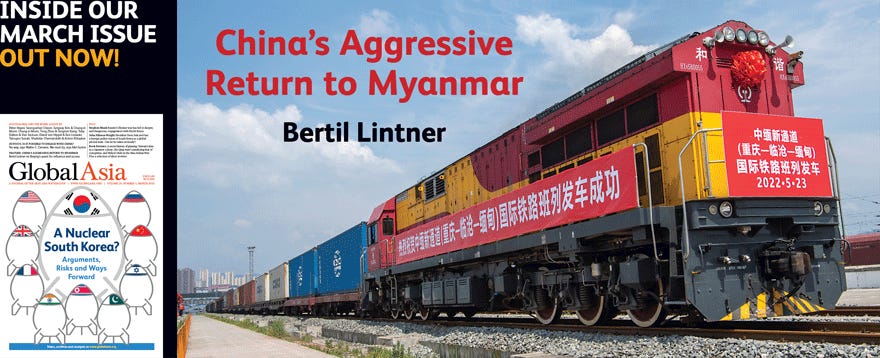China's forceful re-engagement with Myanmar
In the recent history of the nuclear problem on the Korean Peninsula, Jan. 11 was a notable day.
Chung-in Moon
Editor-in-Chief, Global Asia
David Plott
Managing Editor, Global Asia
China-In the recent history of the nuclear problem on the Korean Peninsula, Jan. 11 was a notable day.
South Korean President Yoon Suk Yeol made a significant statement regarding the growing threat from North Korea.
In what appeared to be unscripted remarks, he suggested that Seoul should either request the United States to deploy tactical nuclear weapons on South Korean soil again (which were removed by Washington in 1991), or go nuclear on its own.
While Yoon later qualified his remarks by stating that his country would abide by the Nuclear Non-Proliferation Treaty, the reaction, both domestic and international, was swift. A vigorous debate ensued over the wisdom or folly of a nuclear South Korea.
As our cover package illustrates, the implications would be enormous for Northeast Asia and the world. With the war in Ukraine highlighting the real possibility of Russia using tactical nuclear weapons - something that hasn’t happened since the US dropped atomic bombs on Hiroshima and Nagasaki - fears are legitimate that the world may be creeping toward Armageddon.
One article details the terrifying potential consequences of an exchange of nuclear strikes on the Korean Peninsula, reminding us of the severity of the situation.
As with any crisis, the worst outcome is not inevitable, but the signs are concerning. The US, currently preoccupied with a possible conflict with China over Taiwan, is rallying its alliances to improve its military options in the area. Japan, long committed to its peace constitution, is significantly increasing its defense spending.
China appears ready to expand its nuclear arsenal, while Taiwan is strengthening its ability to defend against a possible invasion by China. Meanwhile, India is cautiously monitoring its ongoing border disputes with China and its own military preparations, including involvement with Washington's Indo-Pacific strategy.
All of this is occurring as North Korea continues to test its expanding missile capabilities and may still perform another nuclear test. It is high time to assess the risks and find a way forward that guarantees peace and stability.
Our In Focus section examines two distinct approaches to China. One argues that engagement by the West is feasible and desirable, while the other maintains that Xi Jinping's unyielding grasp on power makes any change unlikely.
The stakes are high, as China's rise as a global power continues to reshape the international order. The West, including the United States and its allies, is grappling with how to manage China's ascent, while China is seeking to expand its influence and protect its interests.
The two approaches highlighted in our In Focus section reflect differing perspectives on how to approach this complex challenge. One side advocates for continued engagement and cooperation with China, emphasizing the potential benefits of economic integration and cultural exchange. The other side argues that China's authoritarian regime and aggressive behavior require a more confrontational approach, including a renewed emphasis on military deterrence and economic decoupling.
As the world navigates these uncertain waters, it is important to consider both the risks and opportunities presented by China's rise. Ultimately, finding a way to peacefully manage China's ascent will require a nuanced and multifaceted approach that takes into account the complex array of factors at play.
In our Features section, we examine how Myanmar has once again become a site for a geopolitical contest. Beijing is embracing the military government in Naypyidaw to secure access to the Indian Ocean, while the West is shunning and imposing sanctions on Myanmar.
We also explore how the conflict in Ukraine is strengthening the relationship between Russia and North Korea, and the implications of South Korean President Yoon's "middle power" foreign policy aspirations and whether they will lead anywhere.
In our Book Review section, we showcase notable recent works on Asia and offer a more extensive selection of long reviews. We hope you enjoy reading them.



